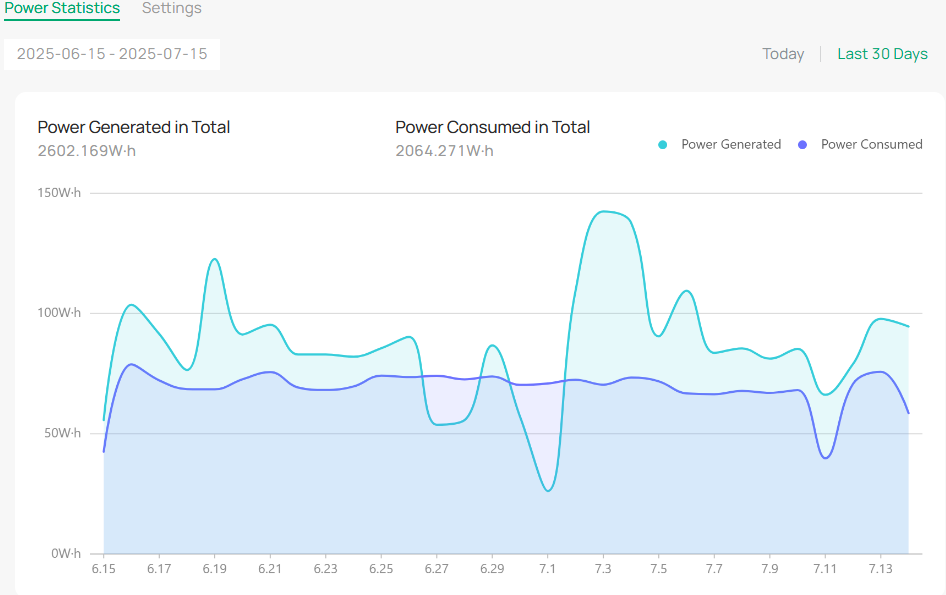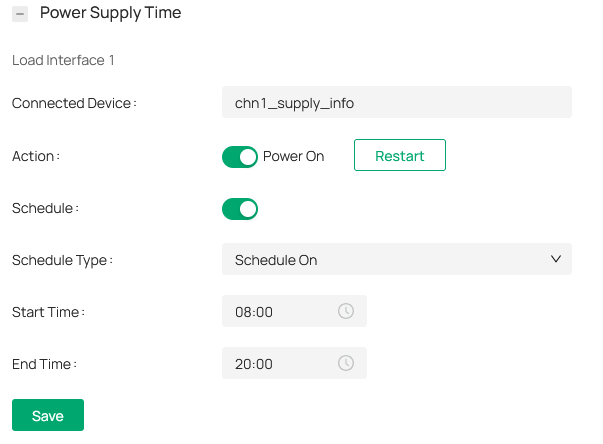Troubleshooting guide for VIGI Solar Panel System
Contents
Introduction
This article provides numerous suggestions for addressing common issues that may arise when using the VIGI Solar Panel System.
Troubleshooting Guidance
Q1. What components does the VIGI Solar Power System include?
A1: The system mainly consists of three parts: solar panels, an integrated bracket with an intelligent controller, and battery modules.
Q2. How many solar panels, batteries, and loads can the solar power system support?
A2:
- VIGI PS90: Supports 2 photovoltaic panels, 3 batteries, and 3 load ports.
- VIGI PS20/30: Supports 1 solar panel, 1 battery, and 3 load ports.
- VIGI SP Series: Fixed package design, supports up to 3 loads.
Q3. Can the VIGI Solar Power System be used with third-party accessories?
A3: Not recommended. Incompatible interfaces or specifications may cause system failure. Use VIGI-certified solar panels, controllers, and batteries.
Q4. What is the output voltage range of the VIGI Solar Power System? Does it vary with battery level?
A4:
- Load Interface #1/2: 9–12.6V (varies with battery level).
- Load Interface #3: Stabilized 12V output (circuit-regulated).
Recommendation: Select interfaces according to load voltage requirements. High-speed PTZ cameras require a stable 12V output, so use Interface #3. All VIGI IPCs are compatible; for C5 series PTZ models, use Interface #3.
Q5. Does the controller consume power? What is its average consumption?
A5: Yes. Average consumption is approximately 0.5W.
Q6. How to install the VIGI Solar Power System?
A6: Please refer to the official installation guide provided with your device, or check this FAQ, How to install VIGI Solar Panel System.
Q7. What do the controller indicator lights signify?
A7: Refer to the table below:
|
Controller LED |
|
|
LED |
Indication |
|
SYS |
On: The system is working and the load is enabled. Off: The system is not working. |
|
LAN |
On: The RJ45 interface is connected. |
|
PV |
On: PV panels are connected and have voltage. |
|
BAT1/2/3 |
On: Battery power is higher than 20%. |
Q8. How to select the appropriate solar system? How to calculate device runtime?
A8: Use the VIGI Solar Power Selector Tool (considering device type, model, and location). The tool calculates specifications and runtime.
Tool link: https://www.vigi.com/en/smb/vigi-solar-power-select-product/
Q9. What load devices are recommended for VIGI Solar Power Systems?
A9: Taking the load equipment working hours of 24 hours/day and the peak sunshine duration of 5 hours/day as an example, the maximum average power consumption of load equipment recommended for different solar power supply systems to maintain stable system operation is as follows:
|
Model |
Maximum Average Load Power |
|
VIGI SP9030 |
9W |
|
VIGI SP6030 |
6W |
|
VIGI SP6020 |
5W |
|
VIGI SP18090 |
18W |
Based on the above assumption, the Average Load Power of an IPC is 3~5W, so the SP9030 supports 2–3 IPCs, and the SP6030/6020 supports 1x 4G-IPC.
The above recommendations are based on laboratory data and public meteorological data, and are calculated through simulation. They are only reference values for network selection. Actual data may vary due to regional climate differences, seasonal climate environment, equipment operating power consumption, solar equipment installation, etc. Please refer to the actual application. For a more detailed equipment selection reference, please use the selection tool mentioned in point 8.
Q10. How to remotely monitor system status?
A10: Two methods:
1. VIGI App: Scan QR code on controller → bind device → view power data.
2. VIGI Cloud VMS: Use Device ID/Serial Number to bind → monitor in cloud platform. (Controller requires network via RJ45 port by connecting to the 4G-IPC/4G-router/bridge)
Q11. How does the App display battery level when PS90 uses multiple batteries?
A11: The App shows the average level of all connected batteries.
Q12. Why is the BAT indicator not lit after battery connection?
A12: Possible causes:
1. Battery is over-discharged.
2. Battery is damaged.
3. Controller is faulty.
4. Indicator broken (if system otherwise normal).
For cause 1&2, a new battery is required for cause 3&4, you may contact technical support for help.
Q13. Why is the controller not powering loads?
A13: Please check:
1. Ensure load voltage ≤12V (24V not supported).
2. Confirm the battery indicator is lit and the connections are secure.
3. Check App battery level – charge or replace battery if needed.
4. Replace the controller if damaged.
Q14. Why is charging power low?
A14: Possible reasons:
1. Confirm power generation on sunny days meets the budget. If much lower, installation or equipment issues may exist.
2. Check panel orientation and obstructions (e.g., trees, buildings). Best time: 10 AM–3 PM.
3. At <0°C, batteries won’t charge and will instead use auxiliary heating, reducing available charging power.
Q15. Why can’t the system run 24h?
A15: Possible causes:
1. Check if there are too many devices connected, resulting in excessive total load power consumption. Use the app, VMS, or other management platforms to check whether recent power consumption has exceeded power generation, causing the battery to be low and unable to maintain stable 24/7 operation.
2. Climate factors, such as shorter daylight hours in winter, can reduce the total daily power generated by the equipment. Over time, the battery may become low if power generation is less than power consumption. This can cause loads to be shut down at night, preventing 24/7 operation.
3. Installation angle and orientation issues can cause seasonal changes in sunlight duration, similar to the problem described in the first point.
4. Check the solar panels for obstructions, such as thick dust, snow, trees, or buildings.
5. Load schedule misconfigured (if battery sufficient).
Q16. Why does the system disconnect occasionally?
A16: Please check:
1. At some point in the evening, the device's battery level comes to a critical low, reaching the threshold for shutting off load power. For the reasons for this, see Q15. Because the device is running at low power and the light intensity is low, the power supply may be insufficient to power the load, causing the device to disconnect.
2. Network instability (wired/WiFi/4G).
3. When using with 4G-IPC, if the device is disconnected for a long time, check the SIM card status to see if it is down or if the data is exhausted.
Q17. How to troubleshoot on VIGI VSM?
A17: You can follow these steps on the VMS management page:
1. Check Device Status. Confirm whether the device status shows Normal. If the status is abnormal, troubleshoot the device itself or the network connection first.

2. Compare Daily Power Data.
-
Check whether the Power Generated in Total is greater than the Power Consumed in Total for the day.
-
If power generation is higher, it means the battery is being replenished and can sustain operation.
-
If consumption is higher, the battery will gradually discharge, which may lead to shutdowns or unstable performance.

3. Review 30-Day Trends.
-
Look at the historical data over the past 30 days.
-
If generation is consistently greater than consumption, the system is stable and the battery can be replenished.
-
If consumption often exceeds generation, adjustments are needed (e.g., reduce load, clean/adjust panels, or upgrade capacity).

Q18. Can external power charge the controller (e.g., PS20/30/90)?
A18: Not recommended. Unknown voltage may damage the controller. Contact technical support if required.
Q19. Why can’t the device be added via local discovery?
A19: Firmware may be outdated. Firmware may be outdated. Since the VIGI Solar Panel device does not have a web interface, it must be added to the cloud management platform before you can upgrade its firmware. However, some models ship with an early firmware version that does not support direct addition to VIGI Cloud VMS.
In such scenarios, please use the VIGI APP, select the Personal mode (My VIGI), and scan the QR code on the device to add it to Personal Cloud Management. Once added, you can then upgrade the device to the latest firmware version.
Q20. How to reset passwords?
A20:
1. With recovery email: Use "Forgot Password" on App/VMS (local) → Reset via email code.
2. Without recovery email: On App → "Forgot Password" → Request verification code from tech support via QR code.
Q21. Can a bound device be re-bound or reset?
A21: No. Must unbind via original account (App/VMS) first.
Q22. Why is there no charging at <0°C or >55°C?
A22: At high temperature (above 55℃), charging and discharging will shut down once the protection is triggered, so there will be no charging power. At low temperatures (below 0℃), charging and discharging are also restricted. If the internal auxiliary heating of the battery is triggered during the day, the charging power will be reduced, and the battery will not actually be charged.
Q23. Why does the battery level jump randomly?
A23: Common causes:
1. Sudden solar exposure change (e.g., shading removed).
2. Entering or exiting protection mode.
Note: If jumps exceed 10% without these conditions, further investigation is required.
Q24. How to set the scheduled power?
A24: Configuration steps (e.g., VMS):
1. Go to Power Schedule settings.
2. Configure schedule:
- To supply power 8 AM–8 PM: set Start = 08:00, End = 20:00, Type = Schedule On.
- To disable power 8 AM–8 PM: set Type = Schedule Off.
3. Save configuration.

Note: Disabling power to networking devices (e.g., 4G IPC) causes a disconnection that cannot be recovered automatically– requires local access to restore.
Q25. What are the installation requirements?
A25: Key points:
1. Zero shading – Panels must be higher than obstacles.
2. Waterproofing – All external interfaces must be waterproofed to avoid short circuits.
3. Cleaning – In dusty, muddy, or snowy environments, clean the panels regularly to maintain efficiency.
How shading and dust affect the power in a lab environment:
|
Real Environment |
Sunny summer in the Northern Hemisphere |
|
|
Test Device |
SP9030 |
|
|
Conditions |
Power Generation/W |
Note |
|
Typical environment without shading and dust |
68 |
/ |
|
Shading 1/6 |
13 |
Loss about 80% |
|
Shading and Dust |
55 |
Loss about 20% |
|
Part Shading and Dust |
28 |
Loss about 60% |
|
Conclusion |
1、Shading affects the power generation quite much, with 1/6 would make power loss to 80%. |
|
How orientation affects the power in a lab environment:
|
Real Environment |
Sunny summer in the Northern Hemisphere at 3 PM, Solar Panel face to the West with inclination angle 35° |
|
|
Test Device |
SP9030 |
|
|
Conditions |
Power Generation /W |
Note |
|
Solar Panel faces the West |
50 |
/ |
|
Solar Panel faces the South |
30 |
Loss about 40% |
|
Solar Panel faces the East |
15 |
Loss about 70% |
|
Conclusion |
The orientation has a significant impact on the power of solar panels. Due to differences in different regions and seasons, it is generally not recommended to install them in an east-west direction. Industry practice recommends installing them in a north-south direction to obtain better average power and sunshine duration. |
|
Note: The above data is only measured in an experimental environment. The actual situation is affected by many factors, such as latitude, regional sunshine, temperature, etc., and is for reference only.
Conclusion
You may meet some problems when using the VIGI Solar Panel System, and this article will help you a lot.
Get to know more details of each function and configuration please go to Download Center to download the manual of your product.
Is this faq useful?
Your feedback helps improve this site.


